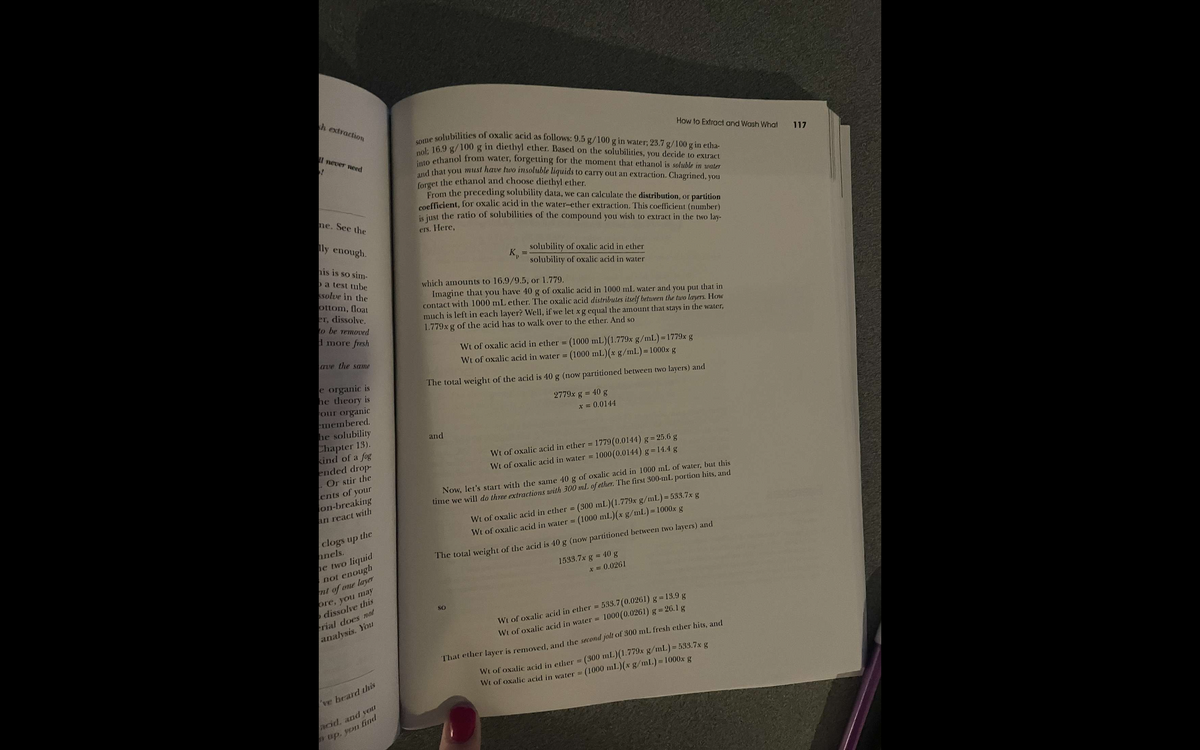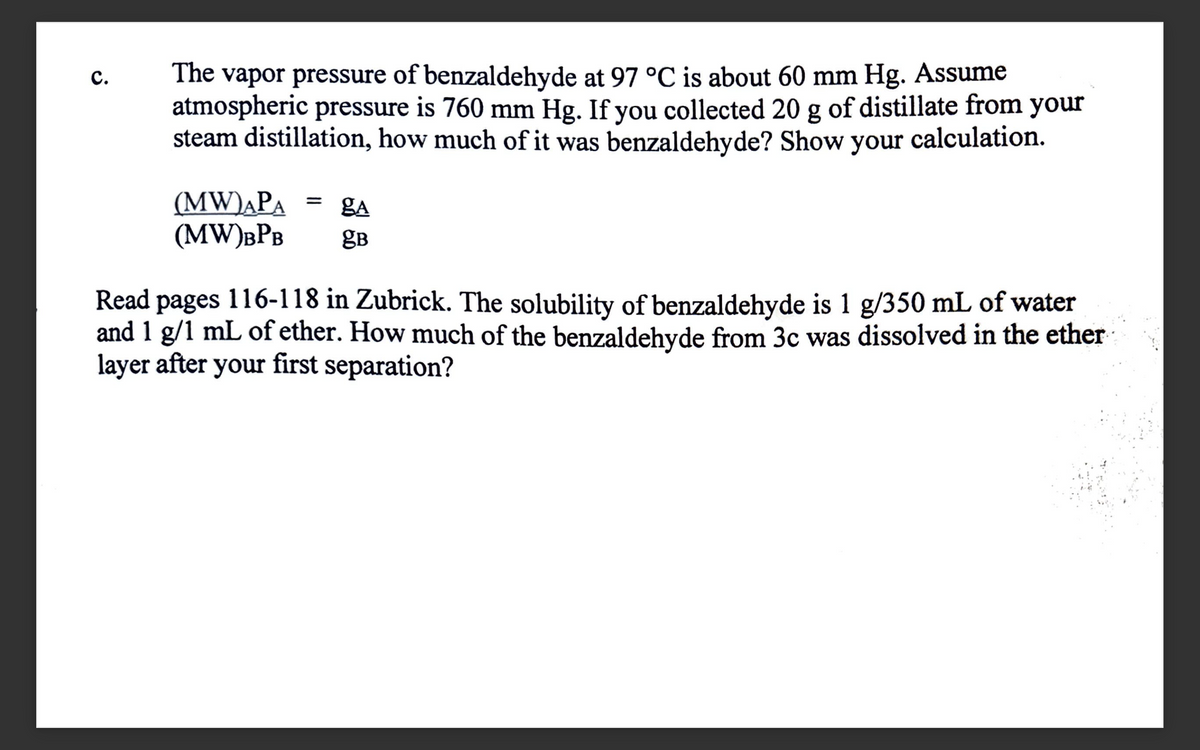The vapor pressure of benzaldehyde at 97 °C is about 60 mm Hg. Assume atmospheric pressure is 760 mm Hg. If you collected 20 g of distillate from your steam distillation, how much of it was benzaldehyde? Show your calculation.
The vapor pressure of benzaldehyde at 97 °C is about 60 mm Hg. Assume atmospheric pressure is 760 mm Hg. If you collected 20 g of distillate from your steam distillation, how much of it was benzaldehyde? Show your calculation.
Chemistry: An Atoms First Approach
2nd Edition
ISBN:9781305079243
Author:Steven S. Zumdahl, Susan A. Zumdahl
Publisher:Steven S. Zumdahl, Susan A. Zumdahl
Chapter10: Properties Of Solutions
Section: Chapter Questions
Problem 91AE: The solubility of benzoic acid (HC7H5O2), is 0.34 g/100 mL in water at 25C and is 10.0 g/100 mL in...
Related questions
Question
The answer to c is 1.58g. Please answer question on bottom.

Transcribed Image Text:h extraction
I never need
ne. See the
lly enough.
his is so sim-
a test tube
solve in the
ottom, float
er, dissolve.
to be removed
d more fresh
ave the same
e organic is
he theory is
our organic
emembered.
he solubility
Chapter 13).
kind of a fog
ended drop-
. Or stir the
ents of your
on-breaking
an react with
clogs up the
anels.
he two
liquid
not enough
nt of one layer
ore, you may
dissolve this
rial does not
analysis. You
've heard this
acid, and you
up, you find
some solubilities of oxalic acid as follows: 9.5 g/100 g in water; 23.7 g/100 g in etha-
nol; 16.9 g/100 g in diethyl ether. Based on the solubilities, you decide to extract
into ethanol from water, forgetting for the moment that ethanol is soluble in water
and that you must have two insoluble liquids to carry out an extraction. Chagrined, you
forget the ethanol and choose diethyl ether.
From the preceding solubility data, we can calculate the distribution, or partition
coefficient, for oxalic acid in the water-ether extraction. This coefficient (number)
is just the ratio of solubilities of the compound you wish to extract in the two lay-
ers. Here,
K₁
and
=
solubility of oxalic acid in ether
solubility of oxalic acid in water
which amounts to 16.9/9.5, or 1.779.
Imagine that you have 40 g of oxalic acid in 1000 mL water and you put that in
contact with 1000 mL ether. The oxalic acid distributes itself between the two layers. How
much is left in each layer? Well, if we let x g equal the amount that stays in the water,
1.779x g of the acid has to walk over to the ether. And so
Wt of oxalic acid in ether= (1000 mL)(1.779x g/mL)=1779x g
Wt of oxalic acid in water = (1000 mL)(x g/mL) = 1000x g
The total weight of the acid is 40 g (now partitioned between two layers) and
SO
How to Extract and Wash What
2779x g = 40 g
x = 0.0144
Wt of oxalic acid in ether = 1779(0.0144) g = 25.6 g
Wt of oxalic acid in water = 1000 (0.0144) g = 14.4 g
Now, let's start with the same 40 g of oxalic acid in 1000 mL of water, but this
time we will do three extractions with 300 mL of ether. The first 300-mL portion hits, and
(300 mL) (1.779x g/mL)=533.7x g
Wt of oxalic acid in ether =
Wt of oxalic acid in water = (1000 mL)(x g/mL) = 1000x g
The total weight of the acid is 40 g (now partitioned between two layers) and
1533.7x g = 40 g
x = 0.0261
Wt of oxalic acid in ether = 533.7 (0.0261) g = 13.9 g
Wt of oxalic acid in water =
1000 (0.0261) g = 26.1 g
That ether layer is removed, and the second jolt of 300 mL fresh ether hits, and
Wt of oxalic acid in ether = (300 mL)(1.779x g/mL) = 533.7x g
Wt of oxalic acid in water = (1000 ml)(x g/mL) = 1000x g
117

Transcribed Image Text:C.
The vapor pressure of benzaldehyde at 97 °C is about 60 mm Hg. Assume
atmospheric pressure is 760 mm Hg. If you collected 20 g of distillate from your
steam distillation, how much of it was benzaldehyde? Show your calculation.
ga
(MW)APA
(MW) BPB gB
=
Read pages 116-118 in Zubrick. The solubility of benzaldehyde is 1 g/350 mL of water
and 1 g/1 mL of ether. How much of the benzaldehyde from 3c was dissolved in the ether
layer after your first separation?
Expert Solution
This question has been solved!
Explore an expertly crafted, step-by-step solution for a thorough understanding of key concepts.
This is a popular solution!
Trending now
This is a popular solution!
Step by step
Solved in 3 steps

Follow-up Questions
Read through expert solutions to related follow-up questions below.
Follow-up Question
How much of the bezaldehyde from c was dissolved in the ether layer after the first separation?
Solution
Knowledge Booster
Learn more about
Need a deep-dive on the concept behind this application? Look no further. Learn more about this topic, chemistry and related others by exploring similar questions and additional content below.Recommended textbooks for you

Chemistry: An Atoms First Approach
Chemistry
ISBN:
9781305079243
Author:
Steven S. Zumdahl, Susan A. Zumdahl
Publisher:
Cengage Learning


Chemistry
Chemistry
ISBN:
9781305957404
Author:
Steven S. Zumdahl, Susan A. Zumdahl, Donald J. DeCoste
Publisher:
Cengage Learning

Chemistry: An Atoms First Approach
Chemistry
ISBN:
9781305079243
Author:
Steven S. Zumdahl, Susan A. Zumdahl
Publisher:
Cengage Learning


Chemistry
Chemistry
ISBN:
9781305957404
Author:
Steven S. Zumdahl, Susan A. Zumdahl, Donald J. DeCoste
Publisher:
Cengage Learning

EBK A SMALL SCALE APPROACH TO ORGANIC L
Chemistry
ISBN:
9781305446021
Author:
Lampman
Publisher:
CENGAGE LEARNING - CONSIGNMENT

Chemistry & Chemical Reactivity
Chemistry
ISBN:
9781133949640
Author:
John C. Kotz, Paul M. Treichel, John Townsend, David Treichel
Publisher:
Cengage Learning

Chemistry & Chemical Reactivity
Chemistry
ISBN:
9781337399074
Author:
John C. Kotz, Paul M. Treichel, John Townsend, David Treichel
Publisher:
Cengage Learning